
The Prince Albert (PA) is a penis piercing which extends from the urethra to the underside of the glans. It is one of the most common male genital piercings. The related reverse Prince Albert piercing enters through the urethra and exits through a hole pierced in the top of the glans.

A bridge piercing is a facial piercing through the skin on the bridge of the nose, usually directly between the eyes of the wearer. A variation on this piercing, the vertical bridge piercing is a surface piercing, with all of the risks or potential complications related to surface piercings.

A navel piercing is a type of piercing that penetrates the skin of the navel. It is most commonly located on the upper fold of skin but can also be affected underneath or around the edges of the navel. Healing usually takes around 6–12 months but varies person-to-person due to differences in physiology.

Nose piercing is the piercing of the skin or cartilage which forms any part of the nose, normally for the purpose of wearing jewelry, called a nose-jewel. Among the different varieties of nose piercings, the nostril piercing is the most common.

An earring is a piece of jewelry attached to the ear via a piercing in the earlobe or another external part of the ear, or, less often, by some other means. Earrings have been worn by people in different civilizations and historic periods, often with cultural significance.

A tongue piercing is a body piercing usually done directly through the center of the tongue. Since its decline in popularity around 2011, it has seen a recent upsurge making it now the second most popular piercing amongst young women aged 18-25 in 2019. It has become quite unpopular amongst men, although in the 1990s and early 2000s, it was more popular for men than women to get and associated with punk culture. Midline tongue piercings, or one hole through the center of the tongue is the most common way to have the tongue pierced.

A frenum piercing is a type of body piercing located on the underside of the shaft of the penis. A series of parallel frenum piercings is known as a frenum ladder. A frenum ladder may be extended to include lorum piercings, hafada piercings and guiche piercings.
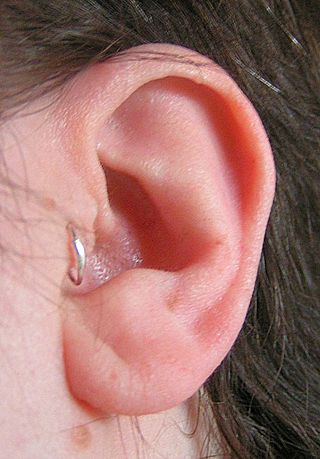
A tragus piercing is the perforation of the tragus, which projects immediately in front of the ear canal, for the purpose of inserting and wearing a piece of jewelry. The piercing itself is usually made with a small gauge hollow piercing needle, and typical jewelry would be a small diameter captive bead ring or small gauge post style piercing jewelry. A related piercing is known as the antitragus piercing.

Surface piercings are piercings that are found on flat parts of the body, giving a double-pierced look that sits flat against the skin. A surface bar follows the plane of skin, while a standard piercing is pierced through the plane. Standard piercings have an entrance hole with an exit hole that is usually directly behind the entrance hole, whereas with a surface piercing the entrance and exit holes are next to each other on the skin surface.
Body piercing jewelry is jewelry manufactured specifically for use in body piercing. The jewelry involved in the art of body piercing comes in a wide variety of shapes and sizes in order to best fit the pierced site. Jewelry may be worn for fashion, cultural tradition, religious beliefs, personal symbolism, and many other reasons.
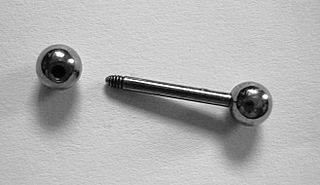
Barbell style piercing jewelry is composed of a straight bar with a bead on each end, one or both beads unscrewable for removal and/or changing of the beads. Often one of the beads is fixed, either via epoxy or welding, so that only one bead is used to install or remove the jewelry. Barbell threads are usually right-handed.
Stretching, in the context of body piercing, is the deliberate expansion of a healed piercing for the purpose of wearing certain types of jewelry. Ear piercings are the most commonly stretched piercings, with nasal septum piercings, tongue piercings and lip piercings/lip plates following close behind. While all piercings can be stretched to some degree, cartilage piercings are usually more difficult to stretch and more likely to form hypertrophic scars if stretched quickly. Dermal punching is generally the preferred method for accommodating larger jewelry in cartilage piercings.
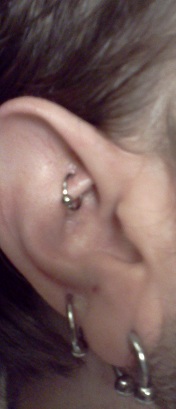
A rook piercing is a perforation of the antihelix of the ear for the purpose of wearing jewelry. It is located just above the tragus on the ridge between the inner and outer conch with the piercing passing from the underside to the top of this ridge, differing from many ear piercings that essentially span between a "front" and "back" surface. Erik Dakota, a well known professional piercer and the individual responsible for originating and popularizing the rook piercing, is said to have named this modification after a shortened version of his first name. The piercing was first named in issue #4 of the magazine Body Play and Modern Primitives Quarterly around 1992 alongside the first printed reference to the industrial piercing, then termed "industrial ear project".

Piercing migration is the process that occurs when a body piercing moves from its initial location. This process can be painful or go unnoticed, until it has progressed. Given enough time, a ring may migrate entirely outside of the skin, although it may only migrate a small amount and come to rest.

An anti-eyebrow is a facial piercing that is placed above the cheek bone or below the eyebrow. Normally it is done with a small surface bar. This piercing can be vertical or horizontal, depending on the person's preference. Though it is a surface piercing, with proper care, placement, and jewelry, it can be a viable long-term piercing. Long-term viability is best with proper surface bars, and significantly reduced when barbells, or curved barbells are used. Often reputable piercers will refuse to do surface piercings, instead preferring sub-dermal implants.

An orbital piercing is a combination of two ear piercings connected by one piece of jewelry. Usually located in the helix region of the ear, an Orbital Piercing can be done anywhere on the body including your earlobes. The piercing uses a hoop, and is not to be confused with an industrial piercing, a conch piercing or double cartilage piercing.
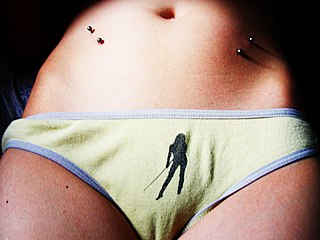
A hip piercing is a piercing in the pelvic area through the skin near the hip bone. Hip piercings are often done in couplets with one on each hip, but it is not unusual to see only one. Hips piercing are a type of surface piercing. Microdermals or skin divers can be implanted in the hip area to give a similar appearance.

In body modification, an implant is a device that is placed under the human skin for decorative purposes. Such implants may be subdermal or transdermal. In the context of body modification, some may consider injections of silicone and other substances a type of implant as well.

Body piercing, which is a form of body modification, is the practice of puncturing or cutting a part of the human body, creating an opening in which jewelry may be worn, or where an implant could be inserted. The word piercing can refer to the act or practice of body piercing, or to an opening in the body created by this act or practice. It can also, by metonymy, refer to the resulting decoration, or to the decorative jewelry used. Piercing implants alter the body and/or skin profile and appearance. Although the history of body piercing is obscured by popular misinformation and by a lack of scholarly reference, ample evidence exists to document that it has been practiced in various forms by multiple sexes since ancient times throughout the world. Body piercing can be performed on people of all ages, although most minors are only permitted to have earlobe piercings.
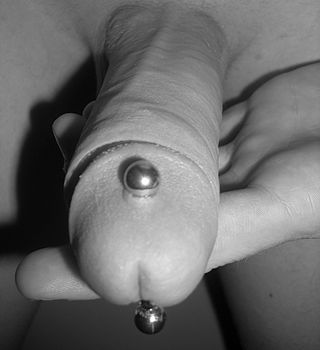
The apadravya, like the ampallang, is a genital piercing that passes through the glans. While the ampallang passes horizontally through the glans, the apadravya passes vertically through the glans from top to bottom, almost always placed centrally and passing through the urethra. It can be paired with an ampallang to form the magic cross. Off-center apadravyas are also possible, wherein the piercing is deliberately offset, yet usually still passes through the urethra. The piercing is often done on a slightly forward angle to the hips.


















